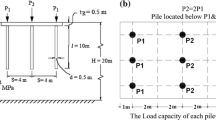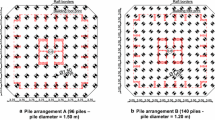Abstract
Most conventional piled raft design methods focus on ultimate limit state and/or serviceability limit state, with economics being evaluated afterward. Economics is a basic requirement of the piled raft foundation design. The piled raft foundation cost estimation consists of two tasks: the material quantities and the construction labor, and its assembly include three tasks: installation, reinforcement and concrete. In this paper, piled raft construction cost is the objective function and the piled raft design parameters such as: allowable settlement, allowable differential settlement and maximum moment of the raft, are the performance indices. The design procedure in this study was obtained through two stages. At the first stage, different pile configurations were considered and the pile length, diameter and the space were changed for obtaining equal construction cost in all pile configurations. At the second stage, performance indices for each pile configuration were calculated. Each pile configuration has a maximum performance index, which is the optimum pile configuration. Sensitivity of the studies on the pile raft cost shows that, for typical pile raft foundation design, pile spacing and configuration are the key parameters in economic design. In general, it is recommended that, according to a given applied load (amount of load and load type), the optimum pile configuration method should be used in combination with a reasonable increasing of the pile length and/or pile positions to achieve the best possible behavior of the piled raft foundation.










Similar content being viewed by others
References
El Gendy M, Hanish J, Kany M (2006) Empirical nonlinear analysis of piled raft. Bautechnik 83(9):604–617
El Gendy M (2007) Formulation of a composed coefficient technique for analyzing large piled raft. Sci Bull Fac Eng Ain Shams Univ 42(1):29–56
Horikoshi K, Randolph MF (1998) A contribution to the optimum design of piled rafts. Géotechnique 48(2):301–317
Kany M, El Gendy M, El Gendy A (2006) Benutzerhandbuch für das Programm ELPLA (einige Bunden in das Programmsystem GEOTEC), Zirndorf
Lee J, Kim Y, Jeong S (2010) Three-dimensional analysis of bearing behavior of piled raft on soft clay. Comput Geotech 37:103–114
Mandolini A, Viggiani C (1997) Settlement of piled foundations. Géotechnique 47(4):791–816
Poulos HG (1994) An approximate numerical analysis of pile-raft interaction. Int J Numer Anal Methods Geomech 18(2):73–92
Poulos HG (2001) Piled raft foundations: design and applications. Géotechnique 51:95–113
Rabiei M (2010) Effect of pile configuration and loading type on piled raft foundations performance. In: ASCE, deep foundations and geotechnical in situ testing (GSP 205), pp 34–41
Rabiei M (2009) Parametric study for piled raft foundations. Electron J Geotech Eng 14(Bundle A):1
Rabiei M, Janalizadeh Choobbasti A (2016) Piled raft design strategies for high rise buildings. Geotech Geol Eng 34(1):75
TC18 (2001) Methods of analysis of piled raft foundations. A report prepared on behalf of technical committee on piled foundations, international society of soil mechanics and geotechnical engineering
Author information
Authors and Affiliations
Corresponding author
Appendix
Appendix
Correlations with SPT (based on the work of decourt)
-
Raft ultimate bearing capacity \((P_{\text{ur}} )\):
$$P_{\text{ur}} = K_{1} \times N_{\text{r}} \;{\text{KPa}}$$ -
Pile ultimate shaft resistance \((f_{\text{s}} )\):
$$f_{\text{s}} = a \times [2.8 \times N_{\text{s}} + 10] \;{\text{KPa}}$$ -
Pile ultimate base resistance \((f_{\text{b}} )\):
$$f_{\text{b}} = K_{2} \times N_{\text{b}} \;{\text{KPa}}$$ -
Soil Young’s modulus below raft \((E_{\text{sr}} )\):
$$E_{\text{sr}} = 2 \times N\;{\text{MPa}}$$ -
Young’s modulus along and below of the pile (vertical loading) \((E_{\text{s}} )\):
$$E_{\text{s}} = 3 \times N\;{\text{MPa}}$$
where \(N_{\text{r}}\) = average SPT (N60) value within depth of one half of the raft width; \(N_{\text{s}}\) = SPT value along pile shaft; \(N_{\text{b}}\) = average SPT value close to pile tip; \(K_{1} ,K_{2}\) = factors shown in Table 4. a = 1 for displacement piles in all soils and non-displacement piles in clays. a = 0.5–0.6 for non-displacement piles in granular soils.
Rights and permissions
About this article
Cite this article
Rabiei, M., Janalizadeh Choobbasti, A. Economic design optimization of piled raft foundations. Innov. Infrastruct. Solut. 3, 65 (2018). https://doi.org/10.1007/s41062-018-0170-3
Received:
Accepted:
Published:
DOI: https://doi.org/10.1007/s41062-018-0170-3




